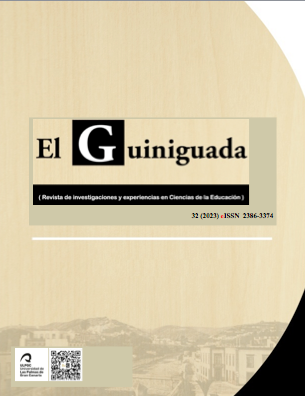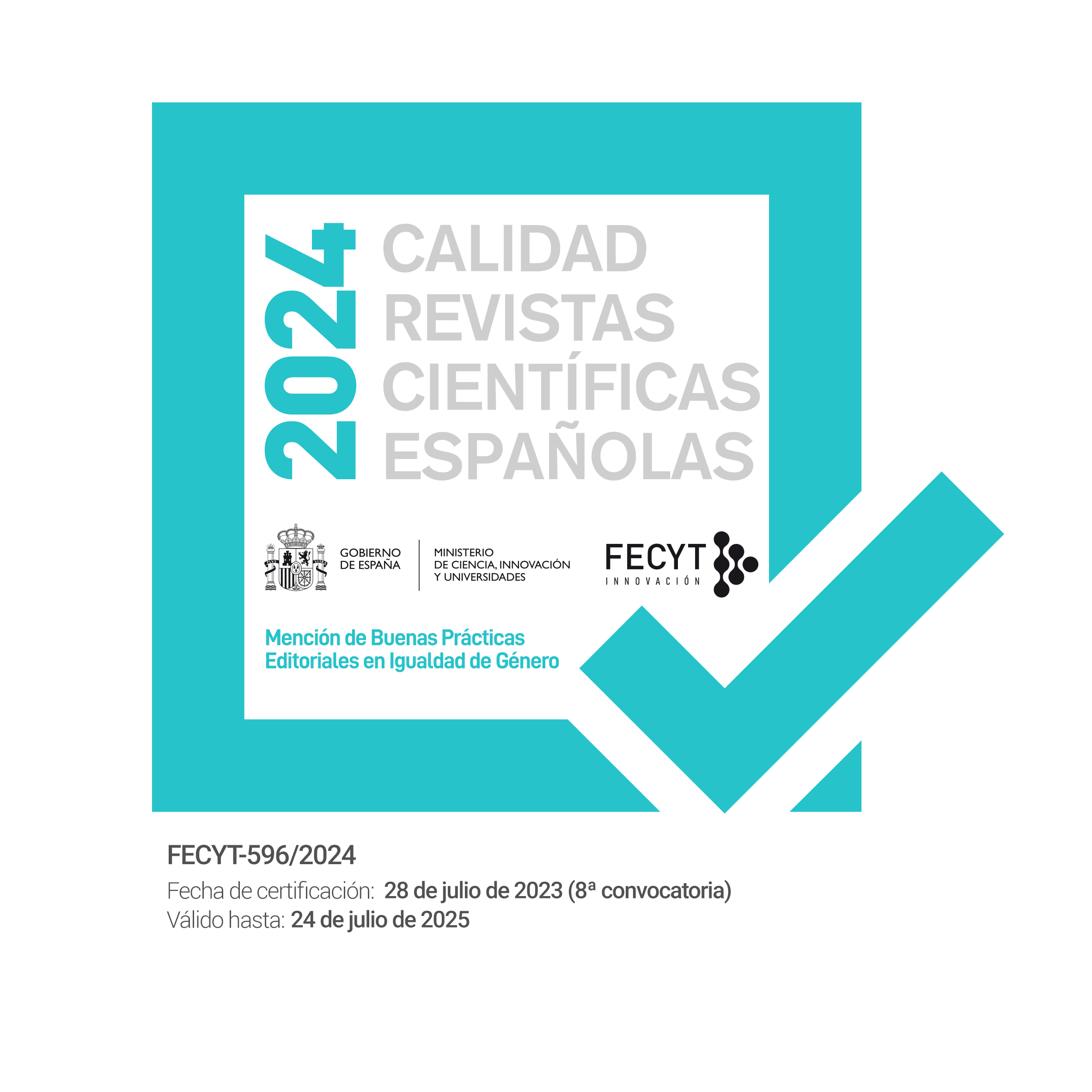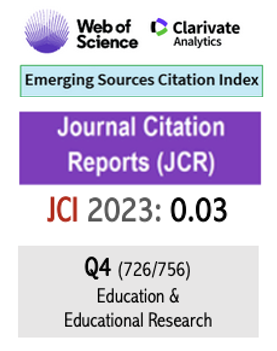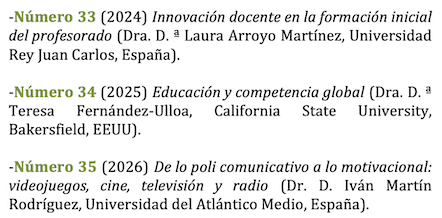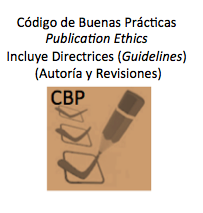The Relationship between Music and Second Languages. La relación entre música y segunda lengua
doi.org/10.20420/ElGuiniguada.2022.506
Palabras clave:
música, segunda lengua, aprendizaje, relaciónResumen
El presente estudio nace de un proyecto de investigación e innovación docente titulado iPlay School of Music and Languages, participado por el Grupo de Investigación HUM-1006, Trinity College España-Portugal, y la Delegación Territorial de Educación, Deporte, Igualdad, Políticas Sociales y Conciliación de Córdoba, que prevé la impartición de clases de música teórica e instrumental en inglés. El objetivo de este estudio es indagar sobre la existencia de una relación entre música y segunda lengua a través de un cuestionario distribuido entre 32 estudiantes de entre 7 y 9 años de edad sobre el gusto de los participantes, sus hábitos de práctica y estudio, y las capacidades en ambos ámbitos. Los resultados confirman la existencia de tal relación y las conclusiones indican que es conveniente profundizar en la investigación para descubrir de qué manera los dos procesamientos pueden beneficiarse mutuamente, con el objetivo de potenciar el aprendizaje en ambas areas.
Descargas
Citas
Allorto, R. (2005). Nuova storia della musica. Ricordi.
Besson, M., Schön, D., Moreno, S., Santos, A., & Magne, C. (2007). Influence of musical expertise and musical training on pitch processing in music and language. Restorative Neurology and Neuroscience, 25, 399–410.
Blacking, J. (1974). How musical is man? University of Washington Press.
Bley-Vroman, R. (1989). What is the logical problem of foreign language learning? In S. Gass & J. Schachter (Eds.), Linguistic perspectives on second language acquisition (pp. 41–68). Cambridge University Press.
Brown, S., Martínez, M. J., & Parsons, L. M. (2006). Music and language side by side in the brain: A PET study of the generation of melodies and sentences. European Journal of Neuroscience, 23, 2791–2803. https://doi:10.1111/j.1460-9568.2006.04785.x
Bühler, K. (1934). Teoría del lenguaje. Alianza Editorial.
Chobert, J. & Besson, M. (2013). Musical expertise and second language learning. Brain Sciences, 3(2), 923–940.
Chomsky, N. (1972). Language and Mind (enlarged ed.). Harcourt Brace Jovanovich.
Chomsky, N. (1975). Reflections on Language. Pantheon Books.
Chomsky, N. (1986). Knowledge of Language: Its Nature, Origin, and Use. Praeger.
Copland, A. (1954). Come ascoltare la musica. Garzanti Editori.
Council of Europe (2018). Common European Framework of Reference for Languages: Learning, teaching, assessment. www.coe.int/lang-cefr.
Dale, P.S. (1980). Is early pragmatic development measurable? Journal of child language,7(1), 1-12. https://doi.org/10.1017/s0305000900006991
De Houwer, A. & Ortega, L. (2019). Introduction. In De Houwer, A. & Ortega, L. (Eds.) (2019). The Cambridge Handbook of Bilingualism (pp. 1–12). Cambridge University Press.
Fromkin, V., Rodman, R., & Hyams, N. (2003). An Introduction to Language. Thomson Wadsworth.
Goodman, J. C., Dale P. S., & Li, P. (2008). Does frequency count? Parental input and the acquisition of vocabulary. Journal of Child Language, 35(3), 515–531. https://doi.org/10.1017/S0305000907008641
Halliday, M. A. K. (1978). El lenguaje como semiótica social. La interpretación social del lenguaje y del significado. Fondo de Cultura Económica.
Harrington, M. (1992). Working memory capacity as a constraint on L2 development. In R. J. Harris (Ed.), Cognitive processing in bilinguals (pp. 123–136). Elsevier.
Hepper, P. G. (1991). An examination of fetal learning before and after birth. The Irish Journal of Psychology, 12, 95-107.
Jakobson, R. (1963). Essais de linguistique genérale. Minuit.
Lerdahl, F. & Jackendoff, R. (1983). A generative theory of tonal music. MIT Press.
Lewis, M. (1993). The Lexical Approach. The State of ELT and a Way Forward. LTP.
Merriam, A. P. (1964). The Anthropology of Music. Northwestern University Press.
Oviedo, H. C. & Campo-Arias, A. (2005). Aproximación al uso del coeficiente alfa de Cronbach. Revista Colombiana de Psiquiatría, 34(4), 572–580.
Pastuszek-Lipinska, B. (2008). Musicians Outperform Nonmusicians in Speech Imitation. Lecture Notes in Computer Science, 4969, 56–73. https://ssrn.com/abstract=1831232
Sachs, C. (2014). Le sorgenti della musica. Bollati Boringhieri.
Sloboda, J. (1985). The Musical Mind: the cognitive psychology of music. Oxford University Press.
Sloboda, J. (2005). Exploring the musical mind: cognition, emotion, ability and function. Oxford University Press.
Toscano Fuentes, C. M., & Fonseca Mora, M. C. (2013). La música como herramienta facilitadora del aprendizaje del inglés como lengua extranjera. Teoría De La Educación. Revista Interuniversitaria, 24(2), 197–213. https://doi.org/10.14201/10361
Weinstock, H. (1969). Cosa è la musica. Oscar Mondadori.
Publicado
Cómo citar
Número
Sección
Licencia
El Guiniguada se distribuye en abierto bajo una licencia Creative Commons Reconocimiento–NoComercial–SinObraDerivada 4.0 Internacional. Permite pues que los autores/as retengan, sin restricciones, los derechos de autoría así como los de publicación y difusión (esta última en una web personal o en un repositorio institucional). Igualmente, los artículos pueden ser descargables y compartirse siempre que se reconozca la autoría, que no se realicen cambios y que no se utilicen comercialmente (CC BY-NC-ND). En los números anteriores a 2020 los derechos de autor/a eran transferidos a la Revista, pero desde el Volumen 29 (2020) se aplica la política de derechos de autoría actual.
La Revista proporciona por tanto un acceso abierto inmediato a su contenido basado en el principio de que ofrecer al público un acceso libre a las investigaciones ayuda a un mayor intercambio global de conocimiento, de acuerdo con la definición BOAI de acceso abierto. Los autores/as no pagan por publicar en El Guiniguada.
El destinatario principal de esta publicación es la comunidad científica en general. No obstante, dado el interés social de los temas vinculados con la educación, El Guiniguada es consciente de la previsible proyección general que sus volúmenes puedan tener. Su acceso abierto permite, igualmente, el conocimiento libre y general de su contenido.
Quienes publiquen en esta revista aceptan pues los términos siguientes:
- Conservarán sus derechos de autoría y garantizarán a la revista el derecho de primera publicación de su obra, el cual estará simultáneamente sujeto a la Licencia de reconocimiento de Creative Commons que permite a terceros compartir la obra siempre que se indique su autoría y su primera publicación en esta revista. Asimismo, se indica que no se puede hacer un uso comercial de la obra; tampoco está permitido su uso derivado.
- Podrán adoptar otros acuerdos de licencia no exclusiva de distribución de la versión de la obra publicada (p. ej.: depositarla en un repositorio institucional o publicarla en un volumen monográfico) siempre que se indique la publicación inicial en esta revista.
- Podrán difundir su obra a través de Internet (p. ej.: en archivos telemáticos institucionales o en los perfiles académicos o profesionales de los autores...) antes y durante el proceso de envío, lo cual puede producir intercambios interesantes y aumentar las citas de la obra publicada. (Véase El efecto del acceso abierto).
Asimismo y de acuerdo con la política de acceso abierto BOAI, todo el contenido está disponible gratuitamente sin cargo para el usuario o su institución. Los usuarios pueden leer, descargar, copiar, distribuir, imprimir, buscar o vincular los textos completos de los artículos, o usarlos para cualquier otro propósito legal, sin solicitar permiso previo del equipo editorial o de la autoría.
